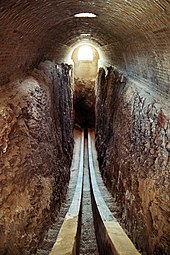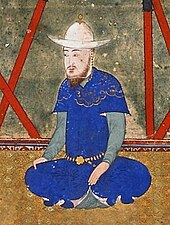Ulugh Beg Observatory
Islamic astronomers who worked at the observatory include Jamshid al-Kashi, Ali Qushji, and Ulugh Beg himself.
Ulugh Beg, the son of Shah Rukh and grandson of Sultan Timur, became the ruler of Samarkand in the 15th century AD.
Many historians have tried to accurately identify the dates of the events that occurred during the Samarkand or Ulugh Beg Observatory.
[2] The differences in interpreting dates and citations of historical sources have caused inaccuracies and neglection of some events during this time.
Other matters such as, political, economic, military, social, and even commercial reasons could have played a role in the building of Ulugh Beg's observatory.
[4] Today, the foundations and the buried part of the marble quadrant are all that are visible of the original vestiges of the Ulugh Beg Observatory.
Much of the decline of the observatory has been attributed to Ulugh Beg's assassination by his son, Abd al Latif, around 1449 (852 AH).
[5] Jamshid Al-Kashi, a 15th-century astronomer and mathematician, is known to have relocated to Samarkand to interact with the scientific processes taking place there.
Having received an invitation from Ulugh Beg, Al-Kashi left his native land of Kashan in north central Iran and went to Samarkand.
The translation, ‘‘[Let us suppose that] the Sun is, e.g., in 10 degrees of Aquarius, with a certain altitude, and the ascendent of time is a certain degree [of the ecliptic]; then [the ascendent of the time when] its [i.e., the Sun's] altitude [is the maximum altitude of the ecliptic at that moment] is a quadrant [in advance of the Sun's position], i.e., in 10 degrees (20) of Taurus", reveals that perhaps Samarkand's scientific atmosphere was more geared towards astrology than previously believed given Krisciunas's paper on the “Legacy of Ulugh Beg” where astrology has an extremely limited discussion.
The Fakhrı sextant, stood on top of a rock into which some of it was carved, so the edifice would not be tall given the soft bricks of the area.
Al-Kashi compares this to Maragha, saying that the sextant is positioned higher there but also notes the flat roof present in Samarkand should facilitate scientific improvement given the fact that “instruments may be placed on it”.
Moreover, the scientific atmosphere of Samarkand was one of general isolation because Al-Kashi describes the stout adherence to Ptolemy's methodologies and lack of awareness for happenings of the Maragha observatory.
The lack of awareness and strict adherence to prior methods by Ulugh Beg himself reveals the perhaps provincial nature of their studies.
[12] According to Bageri's translation of Al-Kashi's letter, a lot of teaching was going on there strictly from memory by teachers who had learned from astronomers in Herat.
"To do them justice, [I must admit that] (30) when there is a discussion in their meeting, I dare not intervene, all the more so because His Majesty knows this art well and [therefore] one cannot impudently claim competence.
"[8] Ulugh Beg fostered an environment with some of the best astronomers of the time, and they all observed and calculated the positions of thousands of stars.
[7] One of the scientists with whom Jamshid al-Kashi would study was Yusuf H. allaj, who had prior experiences in Herat, Egypt, Syria, Anatolia, and adjacent regions.
Zīj-i Sultānī (Persian: زیجِ سلطانی) is a Zij astronomical table and star catalogue that was published by Ulugh Beg in 1437.
The primary instrument used to obtain the information in the Zij-I Sultani came from Ulugh Beg's observatory quadrant.
The Zij was influential and was continuously used until the 19th century and hundreds of copies of the original Persian manuscript exist around the world.




